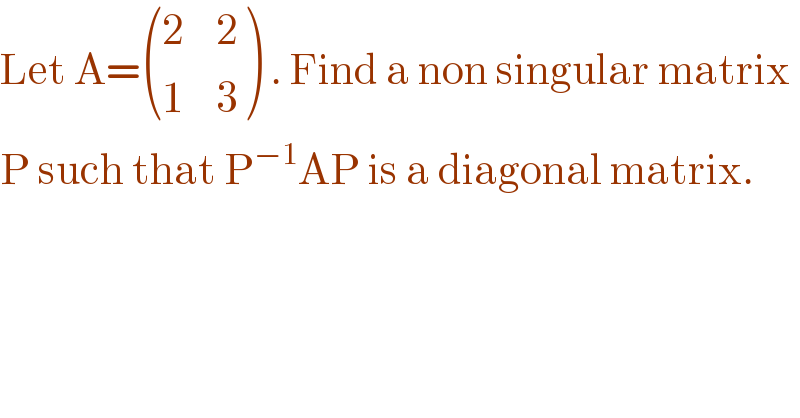
Question and Answers Forum
Previous in Matrices and Determinants Next in Matrices and Determinants
Question Number 98250 by bobhans last updated on 12/Jun/20

Commented by john santu last updated on 12/Jun/20
![find eigen vector det(A−λI)=0 determinant (((2−λ 2)),(( 1 3−λ)))= 0 ⇒λ = 1; 4 Eigen vector for λ = 1 (A−I) ((x),(y) ) = ((0),(0) ) ⇒ (((1 2)),((1 2)) ) ((x),(y) ) = ((0),(0) ) eigen−vector [((−2)),(( 1)) ] for λ = 4 ⇒ (((−2 2)),(( 1 −1)) ) [(x),(y) ]= ((0),(0) ) → x−y = 0 ; eigen−vector = [(1),(1) ] ∴ P = [((−2 1)),(( 1 1)) ] such that P^(−1) AP = [((1 0)),((0 4)) ]■](Q98253.png)
| ||
Question and Answers Forum | ||
Previous in Matrices and Determinants Next in Matrices and Determinants | ||
Question Number 98250 by bobhans last updated on 12/Jun/20 | ||
 | ||
Commented by john santu last updated on 12/Jun/20 | ||
![find eigen vector det(A−λI)=0 determinant (((2−λ 2)),(( 1 3−λ)))= 0 ⇒λ = 1; 4 Eigen vector for λ = 1 (A−I) ((x),(y) ) = ((0),(0) ) ⇒ (((1 2)),((1 2)) ) ((x),(y) ) = ((0),(0) ) eigen−vector [((−2)),(( 1)) ] for λ = 4 ⇒ (((−2 2)),(( 1 −1)) ) [(x),(y) ]= ((0),(0) ) → x−y = 0 ; eigen−vector = [(1),(1) ] ∴ P = [((−2 1)),(( 1 1)) ] such that P^(−1) AP = [((1 0)),((0 4)) ]■](Q98253.png) | ||